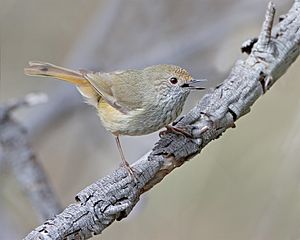Brown thornbill facts for kids
Quick facts for kids Brown thornbill |
|
|---|---|
 |
|
| Conservation status | |
| Scientific classification | |
| Genus: |
Acanthiza
|
| Species: |
pusilla
|
The brown thornbill (Acanthiza pusilla) is a small passerine bird. You can usually find it in eastern and south-eastern Australia, including Tasmania. This bird can grow up to about 10 centimeters (4 inches) long. It mainly eats insects. Brown thornbills are brown, grey, and white. There are five different types, or subspecies, of this bird.
Contents
About the Brown Thornbill
The brown thornbill belongs to a bird group called Passeriformes. This group includes many songbirds. It is part of the Acanthizidae family. The famous scientist George Shaw first described this bird in 1790.
What's in a Name?
The name Acanthiza comes from ancient Greek words. These words mean 'thorn-brake' and 'to live'. This suggests the bird lives in thorny bushes. The second part of its scientific name, pusilla, is Latin. It means 'very small', which perfectly describes this tiny bird.
Bird Family Tree
Scientists have studied the brown thornbill's DNA. They found that its ancestor split from the mountain thornbill about 2 million years ago. This helps us understand how different bird species are related.
What Does It Look Like?
The brown thornbill has warm brown to olive-brown feathers on its back. Its sides are olive-buff to yellowish white. It has cool buff-colored marks on its forehead. Its eyes are a large, dark red.
Its throat and chest have blackish streaks on a grey background. The bird also has a reddish-brown rump and tail base. The tail has a black band near the end with lighter tips.
Size and Weight
Brown thornbills are quite small birds. They are usually between 9 and 10 centimeters (3.5 to 4 inches) long. They are also very light, typically weighing only about 7 grams (0.25 ounces). That's less than a pencil!
Where Do They Live?
You can find brown thornbills in eastern and south-eastern Australia. This includes the island of Tasmania. They usually live within 300 kilometers (186 miles) of the coast. They share their home with other thornbills in places like the Great Dividing Range. They are also common in the Blue Mountains.
Their Homes
Brown thornbills live in many different places. They can be found in dry forests with lots of plants close to the ground. They also live in rainforests and shrublands. You might see them in coastal dune thickets. They also like rushes and ferns along rivers and creeks. They can live at elevations up to 1,200 meters (3,900 feet) high. These birds usually stay in one area and are common. However, they are less common in drier regions.
How Do They Behave?
Their Songs and Calls
Brown thornbills are amazing singers! They can even copy the calls of other birds. People have described their calls as a "rich, musical warble." Their calls can be a mellow "pee-orr," high whistles, or many squeaks and chirps.
Adult brown thornbills can even mimic the alarm calls of other birds. For example, they can sound like a New Holland honeyeater warning about a hawk. This helps scare away predators like pied currawongs from their nests.
What Do They Eat?
The brown thornbill mostly eats insects. Its diet includes spiders, beetles, and ants. It also eats tiny insects called lerp insects and grasshoppers. Sometimes, they might eat seeds, fruit, or nectar from flowers.
They usually look for food close to the ground. They also search in the lower parts of trees and shrubs. Brown thornbills often feed in groups with other thornbills. However, they feed alone during the breeding season. They also join mixed groups with other birds. These include the yellow-rumped thornbill and the eastern yellow robin.
Building a Family
Brown thornbill couples often stay together for a long time. Their nests are shaped like a dome with a side entrance. They build them from grasses, bark, moss, and feathers. They use spider webs to hold it all together. Nests are usually low in bushes, among ferns or clumps of grass.
A female brown thornbill usually lays two to four eggs. Three eggs are the most common number. The eggs are whitish with reddish-brown spots. They are about 16 by 12 millimeters (0.6 by 0.5 inches) in size. The eggs hatch after about 19 days. The young birds stay in the nest for about 16 days. Their breeding season is from July to January.
Keeping Them Safe
The brown thornbill is a widespread bird. Its population is stable. Because of this, it is listed as least concern on the IUCN Red List. This means it is not currently at risk of disappearing.
However, one type of brown thornbill is in trouble. The King Island brown thornbill (A. p. archibaldi) is critically endangered. This means it is very likely to go extinct. For many years, there were very few sightings of this bird. But recent surveys suggest there might be 20 to 50 of them left on King Island. Because of this, a plan to help them recover was expected to start in late 2019.
See also
 In Spanish: Acantiza parda para niños
In Spanish: Acantiza parda para niños



